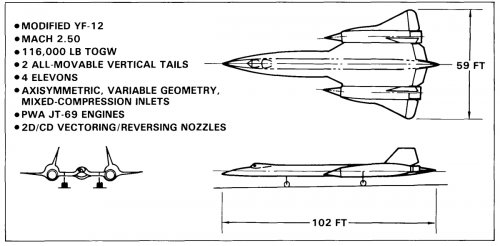- Joined
- 1 April 2006
- Messages
- 11,025
- Reaction score
- 8,327
<...A study was conducted to determinehhe impact of integrated flight, inlet, and engine control system architectures on system
effectiveness (safety, mission reliability, maintainability, dispatchability, and availability) and life cycle cost (LCC). The aircraft
is a modified Lockheed YF-12 with a cruise Mach number of 2.5. It has advanced technology engines, mixed-compression inlets,
and vectoring/reversing nozzles.>
<The aircraft, which formed the basis of this study is a modified Lockheed YF-12 with cruise Mach number 2.5. The aircraft
uses advanced technology Pratt and Whitney Aircraft JT-69 afterburning, low-bypass turbofan engines. The inlets are axisymmetric, mixed-compression, variable geometry. The nozzles are two-dimensional, converging-diverging with thrust-vectoring and thrust reversing.>
From
Integrated Flight/Propulsion Control System Architectures for a High Speed Aircraft
L.H. Bangert and K.R. Henke
Lockheed-California Co., Burbank, CA
R.J. Grommes
Honeywell, Minneapolis, M N
W.B. Kerr
Pratt and Whitney Aircraft, West Palm Beach, FL
AlAA Aircraft Design, Systems and Technology Meeting
October 17-1 9, 19831Fort Worth, Texas
effectiveness (safety, mission reliability, maintainability, dispatchability, and availability) and life cycle cost (LCC). The aircraft
is a modified Lockheed YF-12 with a cruise Mach number of 2.5. It has advanced technology engines, mixed-compression inlets,
and vectoring/reversing nozzles.>
<The aircraft, which formed the basis of this study is a modified Lockheed YF-12 with cruise Mach number 2.5. The aircraft
uses advanced technology Pratt and Whitney Aircraft JT-69 afterburning, low-bypass turbofan engines. The inlets are axisymmetric, mixed-compression, variable geometry. The nozzles are two-dimensional, converging-diverging with thrust-vectoring and thrust reversing.>
From
Integrated Flight/Propulsion Control System Architectures for a High Speed Aircraft
L.H. Bangert and K.R. Henke
Lockheed-California Co., Burbank, CA
R.J. Grommes
Honeywell, Minneapolis, M N
W.B. Kerr
Pratt and Whitney Aircraft, West Palm Beach, FL
AlAA Aircraft Design, Systems and Technology Meeting
October 17-1 9, 19831Fort Worth, Texas

